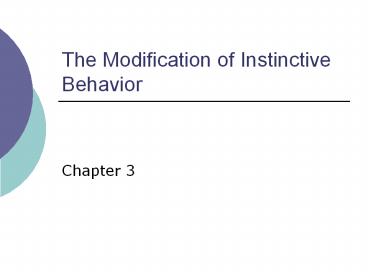The Modification of Instinctive Behavior PowerPoint PPT Presentation
1 / 21
Title: The Modification of Instinctive Behavior
1
The Modification of Instinctive Behavior
- Chapter 3
2
Instinctive Systems
- Lorenz Tinbergen evolution occurs when a
species incorporates environmental knowledge into
its genetic structure. - Greylag goose and egg-rolling.
- Learning can sometimes modify instinctive
behavior even though the fixed action patterns
are innate.
3
Energy Model
- Action-specific energy builds up but is blocked
(inhibited). - The energy motivates appetitive (approach)
behavior. - Presence of a sign stimulus releases the energy
by stimulating an innate releasing mechanism. - The behavior occurs as a fixed action pattern (or
chain of actions).
4
Releasing Signs
- Releasing signs can be complex
- Grayling butterfly signs include darkness of
female, distance from male, and pattern of
movement. - Intensity of the sign influences the behavior but
so does the amount of accumulated energy (time
since the last response).
5
Hierarchical System
- Specific behaviors are controlled by a central
instinctive system. - Energy can accumulate at each level in the
system. - Hormones generate energy.
- Release of energy at higher levels flows to lower
levels. - The sign stimulus determines which behavior will
occur.
6
Conflicting Motives
- If two incompatible signs appear at the same
time, energy flows to a third instinct system. - This third behavior is called displacement.
7
Conditioning Affects Behavior
- Conditioning experiences can change sensitivity
to releasing signs. - Only the consummatory response (eating, mating)
at the end of a chain cannot be changed. - Conditioning fine tunes the response to the
environment and enhances survival.
8
Lorenz Energy Model
9
Criticisms of the Energy Model
- Best viewed as a metaphor.
- The brain does not literally accumulate energy in
any centers and nothing flows. - Willows Hoyle alternating contractions in sea
slug allow it to escape from a starfish. - Brain areas producing this response do not
correspond to energy model.
10
Acquired Changes in Response
- Habituation response to a repeated stimulus
decreases with experience. - Sensitization response to a repeated stimulus
increases with experience. - Examples
- Ingestional neophobia, fear of new food
- Startle response
11
Experimental Evidence
- Rats drink little saccharin water at first but
increase over time. - Loud tones (110 db) produce different responses
depending on the background noise (60 vs 80 db). - Habituation occurred at 60 db
- Sensitization occurred at 80 db
- A loud background is arousing, leading to greater
reactivity, not less.
12
Conditions Producing Change
- More intense (stronger) stimuli produce stronger
sensitization, less likely to produce
habituation. - Greater sensitization and habituation occur when
the stimulus is repeated frequently. - Changes in the stimulus prevent habituation.
- Turkeys habituate but respond again if the shape
changes.
13
Conditions (Cont.)
- Sensitization can occur to many kinds of stimuli
but habituation occurs only with innate
responses. - Habituation and sensitization are transient (go
away after seconds or minutes between stimuli). - Except long-term habituation.
- Dishabituation response returns when a
sensitizing stimulus occurs.
14
Dual Process Theory
- Groves Thompson suggest that sensitization
originates in the central nervous system. - Drugs that stimulate the CNS increase readiness
to respond. - Garcia suggests that the ability to modify innate
reactions has considerable adaptiveness.
15
Evolutionary Theory
- Eisenstein et al. suggest that this is a
fine-tuning of sensory stimuli to recognize
important stimuli. - Habituation sensitization are non-associative
forms of learning. - Their function is to modify sensory thresholds to
adjust to environment. - High responders low responders adjust in
different ways to same stimulus.
16
Cellular Modification Theory
- Aplysia California sea slug
- Learning can permanently alter the functioning of
neural systems. - The change takes place at the synapse of the
neurons. - Stimulation by an external stimulus produces the
change.
17
Dishabituation
- Habituation disappears when the environmental
stimulus changes. - In the aplysia, the neural status may return to
the previous condition. - An alternative view is that sensitization occurs
to modify the responding. - The mechanism remains unclear.
18
Opponent-Process Theory
- An explanation for addictions.
- All experiences produce an affective reaction
(pleasant or unpleasant) called the A state. - This reaction gives rise to its opposite called
the B state. - B state is less intense and lasts longer.
- Over time, the A state diminishes and the B state
increases.
19
Opponent Process Model
20
The Addiction Process
- Tolerance diminished A state.
- Withdrawal increased B state.
- Addictive behavior is a coping response to the
change in B state. - People try to enhance A state to offset the
unpleasantness of the B state. - Without withdrawal symptoms there is no addictive
behavior. - Time prevents B state strengthening.
21
What Sustains Addiction?
- The B state is a non-specific aversive feeling.
- Anything similarly aversive will motivate the
addictive behavior, even if it has no relation to
the substance. - Daily life stress produces a B state that results
in behavior to create an A state. - Parachute jumpers create a B state in order to
feel the A state.

